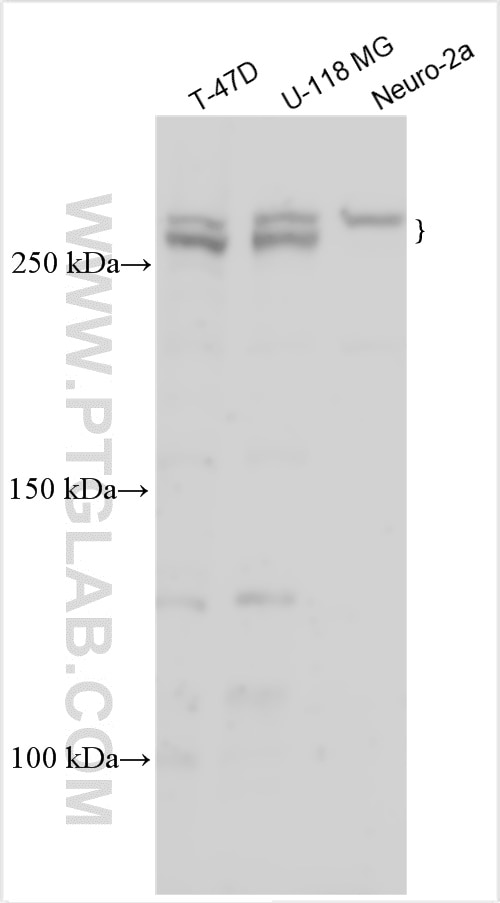Tested Applications
| Positive WB detected in | T-47D cells, U-118 MG cells, Neuro-2a cells |
Recommended dilution
| Application | Dilution |
|---|---|
| Western Blot (WB) | WB : 1:500-1:3000 |
| It is recommended that this reagent should be titrated in each testing system to obtain optimal results. | |
| Sample-dependent, Check data in validation data gallery. | |
Product Information
55207-1-AP targets GOLGA4 in WB, ELISA applications and shows reactivity with human, mouse samples.
| Tested Reactivity | human, mouse |
| Host / Isotype | Rabbit / IgG |
| Class | Polyclonal |
| Type | Antibody |
| Immunogen | Peptide Predict reactive species |
| Full Name | golgi autoantigen, golgin subfamily a, 4 |
| Calculated Molecular Weight | 161 kDa |
| Observed Molecular Weight | 260-270 kDa |
| GenBank Accession Number | NM_002078 |
| Gene Symbol | GOLGA4 |
| Gene ID (NCBI) | 2803 |
| RRID | AB_3670242 |
| Conjugate | Unconjugated |
| Form | Liquid |
| Purification Method | Antigen affinity purification |
| UNIPROT ID | Q13439 |
| Storage Buffer | PBS with 0.02% sodium azide and 50% glycerol, pH 7.3. |
| Storage Conditions | Store at -20°C. Stable for one year after shipment. Aliquoting is unnecessary for -20oC storage. 20ul sizes contain 0.1% BSA. |
Background Information
GOLGA4, also known as Golgi matrix protein, is a member of the Golgin family and is mainly localized in the Golgi apparatus. It is involved in vesicle transport at the Golgi level and may play a role in the transport of GPI-anchored proteins from the Golgi network. GOLGA4 is expressed in a variety of tissues, especially in the testis, but its specific function in spermatogenesis and male fertility is not fully understood. Studies have shown that GOLGA4 knockout male mice are still fertile, and the testis and sperm morphology are normal, indicating that GOLGA4 is not essential for mouse spermatogenesis and male fertility (PMID: 32736686).
Protocols
| Product Specific Protocols | |
|---|---|
| WB protocol for GOLGA4 antibody 55207-1-AP | Download protocol |
| Standard Protocols | |
|---|---|
| Click here to view our Standard Protocols |



